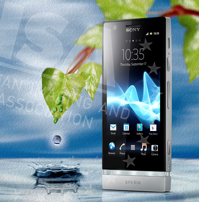And the winners are …… again Philips for its Smart TV and Sony for its Smart Phone. Smart seems to be the clue for sustainability nowadays! :)
While today’s TVs are being offered with ever-bigger screens, this doesn’t have to mean a bigger cost to the environment. With the 55PFL6007, Philips has created a set with increased functionality over its previous models while maintaining its standing as a brand with environmentally efficient products. Not only does the 55PFL6007 outperform its rivals when it comes to energy efficiency but it also boasts the efficient use of precious metals in its printed circuit boards. As such, a Philips TV set wins the EISA Green Award for the third year in succession.
The smart phone market is developing rapidly as models come packed with ever-increasing functionality. Unfortunately, the trend towards the use of bigger screens and embedded batteries can make recycling harder. The Sony Xperia P outperforms the competition in terms of energy performance while making efficient use of materials of environmental concern, such as precious metals and has a low copper content. With the Xperia P, Sony successfully follows the performance of last year’s winner, its Xperia Mini.
Determining the winner is, by the way, not something EISA does by itself.
EISA member-magazines may know a lot about technology and its applications but on environmental issues they generally lack the necessary knowledge to make the right decision. Therefore, on the Norwegian side, the work is coordinated by Prof. Dr. Casper Boks, professor at the University of Science & Technology in Trondheim, on the German side by Dr. ir Jaco Huisman of the United Nations University in Bonn and on the Dutch side by Prof. dr. ir. Jo Geraedts and dr. ir. Renee Wever of the Faculty of Industrial Design Engineering at Delft University of Technology. Worldwide, these gentlemen are recognized as real specialists in green.
Because participating universities do not have the ability to analyse all materials used in mobile phones, they work in close cooperation with Sims Recycling Solutions in Eindhoven, to determine the winner of EISA’s Green Mobile Phone.
Sims Recycling Solutions, recycles 60,000 tons of electronic waste annually, a third of which is in the form of monitors and televisions, and plays a leading role in re-use of components such as computers or telephone equipment that is not at the end of its life cycle.
The most efficient process within the company is an automated machine, which is able to recover almost 100% of metal and glass from a conveyor full of TV’s and monitors. The recycled glass is so clean that it is re-usable for new televisions. Also, plastic recycling is becoming more sophisticated achieving levels of almost 85%.
Besides material recovery, enormous energy savings are achieved. In relation to the energy necessary to recover metals, savings of about 60% are achieved in recycled zinc and lead, 62-74% savings in steel, 85% in copper and up to 95% in aluminum.
Over the years, recycling has become more complex, with a lot of smaller products such as mobile phones and MP3 players containing built-in batteries which are often hidden. These need to be located and removed to prevent contamination and possible explosion during the recycling process. Sims actively tries to collect production blueprints for such devices and is able to advise manufacturers on how to make products more environmentally friendly and easy to recycle.

Comments by our Users
Be the first to write a comment for this item.